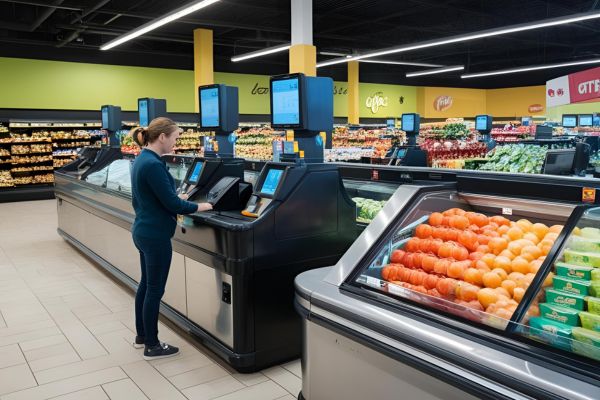Self-checkout machines have revolutionized the way people shop, offering a faster and more convenient alternative to traditional cashier-staffed lanes. Supermarkets worldwide are increasingly adopting these machines to enhance customer experience and streamline operations. By allowing shoppers to scan, bag, and pay for their items independently, self-checkout systems help reduce long queues and improve efficiency. As digital payment methods and automation continue to evolve, self-checkout machines are becoming a key component of modern retail strategies.

What Are Self-Checkout Machines?
Self-checkout machines are automated kiosks that enable customers to complete their purchases without the assistance of a cashier. These machines typically consist of a barcode scanner, touchscreen interface, payment terminal, and bagging area. Shoppers scan their items, follow on-screen instructions, and make payments using cash, cards, or digital wallets. Unlike traditional checkout counters, self-checkout stations give customers greater control over their transactions, leading to a more seamless and personalized shopping experience.
The Rise of Self-Checkout Machines in Supermarkets
The adoption of self-checkout machines has grown significantly over the past decade, driven by technological advancements and changing consumer preferences. Retail giants like Walmart, Tesco, and Carrefour have integrated these systems into their stores to enhance operational efficiency and meet the demands of tech-savvy shoppers.
A study by RBR Research estimated that there were over 500,000 self-checkout machines globally by 2023, with further growth expected in the coming years. Supermarkets are increasingly investing in AI-powered self-checkout systems that can detect unscanned items, prevent fraud, and provide a frictionless checkout experience. As more consumers embrace cashless payments and automation, self-checkout machines are poised to become a standard feature in retail stores worldwide.
Benefits of Self-Checkout Machines in Supermarkets
Faster Checkout Process
Self-checkout machines significantly reduce waiting times by allowing multiple customers to scan and pay for their items simultaneously. Unlike traditional checkout lanes, which rely on cashiers to process each customer individually, self-checkout stations increase efficiency, especially during peak hours. According to a study by NCR, supermarkets with self-checkout lanes can process customers up to 40% faster compared to those relying solely on staffed counters.
Cost Savings for Retailers
Supermarkets benefit from self-checkout machines by reducing labor costs. While cashiers are still needed for customer assistance, fewer employees are required at checkout stations, allowing retailers to allocate resources to other areas like restocking and customer service. A report from FMI (Food Marketing Institute) suggests that retailers can save up to 30% in labor expenses by incorporating self-checkout technology.

Convenience for Shoppers
Many customers appreciate the autonomy of scanning and bagging their groceries at their own pace. Self-checkout machines cater to individuals who prefer a quick and hassle-free shopping experience, particularly those purchasing only a few items. With contactless payment options integrated into most machines, transactions are seamless and efficient, further enhancing convenience.
Reduced Human Error
Traditional checkout lanes can occasionally experience scanning errors or miscalculations. Self-checkout machines minimize such risks by using advanced barcode scanning and weight-sensing technology. These systems automatically detect discrepancies, ensuring accurate pricing and reducing instances of incorrect charges or unscanned items.
Improved Social Distancing and Hygiene
The rise of self-checkout machines became even more significant during the COVID-19 pandemic, as they helped reduce direct human interaction. Even in the post-pandemic era, consumers continue to prioritize minimal contact with shared surfaces. Self-checkout stations, particularly those with touchless payment features, provide a hygienic alternative to conventional cash registers.
Enhanced Shopping Experience
Self-checkout machines allow supermarkets to improve the overall shopping experience. By providing a mix of traditional and automated checkout options, stores cater to different customer preferences. Many supermarkets also integrate loyalty programs and digital receipts into their self-checkout systems, offering personalized discounts and streamlining payment processes.

Reduction in Checkout Line Congestion
During peak hours, long queues at traditional checkout counters can frustrate customers. Self-checkout machines help distribute traffic by offering an alternative, reducing congestion and making checkout lines more manageable. Studies show that supermarkets with self-checkout lanes can handle a higher volume of shoppers without requiring additional cashier-operated counters.
The Future of Self-Checkout Technology
Self-checkout technology is evolving rapidly, with advancements like AI-powered checkout systems and frictionless shopping experiences transforming the retail industry. AI-driven self-checkout kiosks can recognize items through computer vision, eliminating the need for barcode scanning. Some stores are also adopting frictionless shopping models, where customers can simply walk out with their items while sensors and AI automatically process payments. Retail giants like Amazon have pioneered this with their Just Walk Out technology, and similar innovations are expected to become more widespread.
While these advancements enhance efficiency and convenience, they also raise concerns about the retail job market. As self-checkout technology becomes more sophisticated, traditional cashier roles may decline. However, this shift could lead to new job opportunities in system maintenance, AI training, and customer service for automated stores. Retailers will likely focus on upskilling employees, integrating technology with human assistance rather than fully replacing jobs. The future of self-checkout is a balance between automation and human interaction, shaping a more seamless shopping experience.
Self-checkout Machines are Transforming Shopping
Self-checkout machines are transforming supermarket operations by improving efficiency, reducing costs, and enhancing customer convenience. While they may not entirely replace traditional cashiers, their growing adoption highlights their significant role in modern retail. With continuous advancements in AI and automation, self-checkout systems will likely become even more user-friendly and widespread, further revolutionizing the grocery shopping experience.




